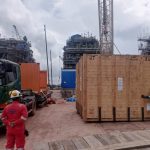How are you, Liga Asuransi Readers?
We hope you are in good health and your business continues to grow successfully! As usual, on this blog we are always committed to providing useful information about risk management and insurance.
This time, we raise a topic that is increasingly becoming a concern for many parties: truck accidents which not only threaten safety, but also have a major impact on the world of logistics and the economy. Why is this issue so important? And what can we do together to overcome it?
If you find this post useful, don’t hesitate to share it with your colleagues. Let’s build awareness of the importance of safety and protection together, because the information you share can be the first step towards better change.
Enjoy reading, and hopefully this article provides new insights for you!
It should be noted that trucks have a vital role in the national logistics system, contributing more than 70% of the total transportation of goods in Indonesia. As the backbone of distribution, trucks ensure the smooth supply of basic necessities, industrial raw materials and finished products to all corners of the country. The efficiency of truck transportation greatly influences economic stability, prices of goods, and Indonesia’s competitiveness in the global market. However, the high number of truck accidents not only impacts fatalities but also causes significant economic losses such as supply chain disruptions. Therefore, addressing the risk of truck accidents is critical to improving the safety, efficiency and sustainability of the national logistics sector.
But unfortunately the risks of operating trucks are very high and have caused losses of billions or perhaps trillions of rupiah and caused hundreds and thousands of injuries.
Throughout 2024 until November, Indonesia experienced several heavy truck accidents which resulted in fatalities and material losses. The following are five significant incidents:
- Accident on the Pemalang-Batang Toll Road (31 October 2024): An expedition truck crashed into a TV One operational car at Km 315+900 Pemalang-Batang Toll Road, Central Java. This accident resulted in three people being killed and two others being injured. This incident highlights the importance of vigilance and compliance with traffic rules on toll roads.
- Reckless Truck in Cipondoh, Tangerang (1 November 2024): A container truck was driven recklessly, hitting many vehicles at Tugu Adipura, Tangerang City. As a result, 16 vehicles were damaged and six people were injured. The truck driver tested positive for the drug methamphetamine, highlighting the problem of substance abuse by heavy transport drivers.
- Truck Hits Child in Teluknaga, Tangerang (7 November 2024): A truck carrying soil hit a 9 year old girl on Jalan Raya Salembaran, Teluknaga, Tangerang Regency. The victim suffered serious injuries to his leg. This incident sparked anger among residents who damaged dozens of other trucks carrying land, showing public dissatisfaction with truck operations which were considered dangerous.
- Successive Accidents on the Cipularang Toll Road (11 November 2024): At Km 92 of the Cipularang Toll Road towards Jakarta, a truck experienced brake failure and crashed into 17 other vehicles. This accident caused one person to die and 25 people to be injured, including four seriously. This incident highlights the importance of regular maintenance and technical inspection of heavy vehicles to prevent similar accidents.
- Five tronton trucks in a series of collisions in Bogor (15 November 2024): Five tronton trucks were involved in a series of collisions on Jalan Raya Sudamanik, Parung Panjang District, Bogor Regency. This accident caused two people to be injured. The incident occurred when a truck hit another truck that was stopped waiting for operating hours, highlighting the importance of coordination and compliance with heavy vehicle operational schedules.
This series of accidents emphasizes the need for increased supervision, education and law enforcement regarding truck operations in Indonesia to ensure road safety.
The main causes of truck accidents include failed brakes, overloading, and unroadworthy vehicle conditions. Other factors such as driver fatigue and lack of vehicle maintenance also contribute significantly. The Ministry of Transportation noted that truck and bus accidents have continued to increase since 2011, with an average of 30,000 cases per year until 2018, up from 10,000 cases per year previously.
The fatality rate due to truck accidents is also high. In 2022, of the total 139,258 traffic accidents, there will be 28,131 deaths.
Although specific data on casualties resulting from truck accidents is not available, the contribution of trucks to the fatality rate is significant, considering the large proportion of accidents involving heavy vehicles.
Law enforcement efforts against violations such as overloading and inadequate vehicle maintenance need to be increased to reduce the number of truck accidents in Indonesia.
Impact of Truck Accidents
Economic Impact
Truck accidents have a significant economic impact. Material losses include vehicle damage, destroyed cargo, and damage to infrastructure such as roads or bridges. This results in high costs for repairs, cargo replacement, and insurance claims. Insurance costs also increase due to the high frequency of claims, which ultimately increases the financial burden for transportation and logistics companies. In addition, accidents cause logistics downtime, where the delivery of goods is stopped or delayed. This can disrupt supply chains, especially for time-sensitive goods such as fresh food or industrial raw materials, which can impact business productivity and revenue.
Social Impact
The social impacts of truck accidents are often more complex and profound. Accidents can cause serious injuries and even loss of life, leaving deep trauma for victims and their families. Apart from that, accidents involving heavy vehicles often have an impact on many parties, such as other road users and the surrounding community. For example, a truck accident that spills dangerous cargo can pollute the environment and endanger public health. Psychological trauma is also a problem, especially for eyewitnesses or survivors.
In addition, truck accidents can cause anxiety in the community regarding road safety, especially in areas with high traffic of heavy vehicles. Public protests, such as those that occurred in the case of land trucks in Tangerang, reflect dissatisfaction with safety regulations that are considered inadequate. Therefore, the social and economic impacts of truck accidents must be addressed with a holistic approach through increased regulation, education and supervision.
Factors Causing the High Risk of Truck Accidents
Truck accidents in Indonesia are influenced by various interrelated factors. These factors include human, vehicle, infrastructure and environmental aspects, which together increase the risk of accidents.
- Driver fatigue due to long working hours
Most truck drivers face pressure to meet tight delivery time targets, so they often work beyond safe work hours. This fatigue reduces concentration and reflexes, increasing the risk of road accidents.
- Lack of driver training and certification
Many truck drivers do not have adequate training or certification in operating heavy vehicles. This leads to a lack of understanding of safe driving techniques, especially in risky situations such as descending steep hills or carrying excessive loads.
- Violation of traffic rules
Violations such as speeding, disobeying traffic lights, and overtaking in unsafe places are the main causes of accidents. Some drivers also ignore safety procedures, such as using seat belts or ensuring a safe distance between vehicles.
- Poor truck maintenance
Many transport companies neglect routine vehicle maintenance to reduce operational costs. Malfunctioning brakes, worn tires, and damaged steering systems are common problems that increase the risk of accidents.
- The vehicle is old and not roadworthy
Trucks that have been in service for years are often unroadworthy. These old vehicles have components that are prone to failure, such as the engine and braking system, which can cause technical failures during use.
- Load that exceeds capacity
The practice of overloading or carrying loads that exceed the truck’s capacity is one of the main causes of accidents. Excessive load can damage the braking and suspension systems, making the vehicle difficult to control, especially when cornering or going uphill.
- The road is damaged and narrow
Many transportation routes in Indonesia, especially in remote areas, have poor road conditions, such as large potholes, cracked asphalt, or inadequate road width. This increases the risk of a heavy vehicle skidding or losing control.
- Lack of traffic signs and supporting facilities
Roads in several areas lack warning signs or directional signs. Supporting facilities such as street lighting, parking areas for rest, and guardrails are also often inadequate, thereby increasing the risk of accidents.
- Congestion on the main road
Traffic jams on main roads, especially around ports and industrial areas, often force truck drivers to take risky alternative routes or break traffic rules to make up time.
- Bad weather
Heavy rain, thick fog and flooding are common weather conditions in Indonesia and can reduce visibility and tire traction. This makes it difficult for drivers to control the vehicle, especially on wet or slippery roads.
- Geographic conditions
Indonesia has many roads with steep inclines, sharp descents and dangerous turns, especially in mountainous areas. This condition requires driver expertise and optimal vehicle performance. However, without proper maintenance and training, this condition becomes a major challenge that often causes accidents.
Human, vehicle, infrastructure and environmental factors contribute to each other in increasing the risk of truck accidents. To reduce risk, there needs to be synergy between drivers, transport companies, government and society to ensure safety on the road. Measures such as driver training, vehicle maintenance, infrastructure improvements and environmental risk mitigation should be a priority.
Efforts to Reduce the Risk of Truck Accidents
Truck accidents can be minimized through strategic steps involving regulations, infrastructure improvements, technology, education and insurance. The following is a description of these steps:
- Regulation and Law Enforcement
Stricter regulations for truck drivers and operators
The government needs to tighten regulations regarding driver working hours, driving certification and vehicle operational suitability. For example, maximum limits on daily working hours must be enforced with strict monitoring mechanisms to prevent driver fatigue.
- Increased surveillance on the road
Law enforcement needs to be improved, especially against violations such as overloading and using vehicles that are not roadworthy. Highway patrols must be equipped with technology to detect these violations in real-time, so that violators can be dealt with immediately.
- Infrastructure Improvements
To reduce the risk of accidents, building special lanes for heavy vehicles is very important, especially in areas with heavy traffic. This lane can separate heavy vehicles from small vehicles, reducing the potential for collisions.
- Investment in road maintenance and supporting facilities
Roads that are damaged, have minimal signs or no lighting need to be repaired on an ongoing basis. The government must also provide supporting facilities such as adequate rest areas for truck drivers to rest, so as to reduce fatigue.
- Technology and Innovation
GPS and telematics technology enable logistics companies to monitor drivers’ speed, routes and behavior. This system can provide early warning to drivers and operators if violations or risks are detected on the road.
- Safety features such as automatic braking and blind-spot sensors
Implementing safety technology in heavy vehicles, such as automatic emergency braking (AEB) systems and blind-spot sensors, can help prevent collisions. This technology becomes important, especially in areas with low visibility or heavy traffic.
- Periodic training program for truck drivers
Truck drivers need to undergo regular training to improve their skills in dealing with various road conditions. This training may also include fatigue management, defensive driving techniques, and understanding the latest regulations.
- Safety campaign to increase public awareness
Safety campaigns need to be carried out widely, both for truck drivers and the general public. For example, campaigns to use the correct lane or avoid truck blind-spot areas can reduce accidents caused by the behavior of other road users.
Role of Insurance
Insurance provides financial protection for truck operators against losses due to accidents. Apart from protecting assets, insurance also helps reduce the costs that must be borne by companies or individuals after an incident.
The importance of adequate insurance coverage
The insurance policy must cover physical loss, damage to cargo, and legal liability to third parties. Truck operators need to work with insurance brokers to ensure they have coverage appropriate to their operational risks.
Reducing the risk of truck accidents requires a holistic approach. Strict regulations, adequate infrastructure, application of advanced technology, continuous education, and the role of insurance are key steps to create a safer transportation environment. Collaboration between governments, logistics companies, drivers and communities is essential to realize this goal.
Challenges in Overcoming the Risk of Truck Accidents
Addressing the risk of truck accidents in Indonesia faces various challenges that hinder the implementation of effective solutions. Here are three main challenges:
- Resistance to Regulatory Change
Changes to stricter regulations, such as limiting drivers’ working hours or implementing Over Dimension Overloading (ODOL) regulations, often meet resistance from logistics companies and drivers. Companies are concerned that these regulations could increase operational costs, while drivers feel the pressure to meet delivery targets will increase. In addition, enforcing new rules requires time and consistency, which sometimes becomes an obstacle at the implementation level.
- High Costs for Technology Implementation and Training
Implementing technology such as GPS, telematics or advanced safety features requires a large initial investment. Many companies, especially small and medium sized ones, do not have the budget to adopt this technology. Apart from that, regular driver training to improve competency also requires additional costs, both for training materials and lost operational time. This hampers efforts to improve overall safety in the truck transportation sector.
- Lack of Coordination Between Stakeholders
One of the biggest challenges is the lack of coordination between the government, truck operators, drivers and the community. The government may issue new regulations without involving operators and drivers in the consultation process, making policies difficult to accept in the field. On the other hand, truck operators often do not have a good communication system with drivers, resulting in policy implementation being ineffective. Lack of community involvement in supporting safety policies is also a factor that complicates the situation.
To overcome this challenge, a collaborative approach is needed between all stakeholders. Governments need to provide incentives for technology adoption and training, while operators and drivers must be involved in the decision-making process. Better coordination will speed up implementation of solutions and improve safety in the trucking sector.
Recommendations and Long Term Solutions
- Integrated Strategy to Reduce the Risk of Truck Accidents
Reducing the risk of truck accidents requires an integrated strategy that covers various aspects. First, the implementation of advanced technologies such as telematics systems and GPS should be a priority to monitor driver behavior and vehicle conditions. The government can provide fiscal incentives or subsidies for logistics companies that adopt this technology. Second, regulations must be updated to ensure limits on working hours, load capacity and vehicle age are applied consistently. Regular training for drivers should also be mandatory to improve their skills and safety awareness.
Apart from that, infrastructure improvements such as building special truck lanes, adding traffic signs and improving road quality must continue to be carried out. Funding can be obtained through public-private partnerships, where the government and logistics companies jointly invest in infrastructure.
- Collaboration Between Government, Logistics Companies and Community
Collaboration is key in overcoming the risk of truck accidents. The government needs to involve logistics companies in the process of formulating regulations so that the policies made are relevant and can be implemented in the field. Logistics companies must commit to complying with regulations, training drivers and maintaining their vehicles.
The community also has an important role through education and safety campaigns. Awareness of the importance of maintaining road safety must be instilled from an early age to reduce risky road user behavior.
With an integrated strategy and strong collaboration, truck accidents can be minimized, creating a safer and more efficient transportation system.
Conclusion
Truck accidents have serious economic, social and road safety impacts. Mitigation measures such as strict regulations, infrastructure improvements, technology adoption, driver training and the role of insurance are essential to reduce this risk. Collaboration between governments, logistics companies, communities and insurance brokers is needed to create a safer and more sustainable transportation system.
Insurance brokers play a strategic role in providing financial protection through policies that suit your needs. All parties must unite in increasing awareness and commitment to safety. Together, we can create a safer and more efficient transportation future.
L&G Insurance Broker is a trusted partner for the best insurance solutions. L&G offers professional services, comprehensive protection and extensive experience in the logistics, construction, energy, vehicle insurance including trucks and other industries. Supported by advanced technology, L&G helps manage risk efficiently, ensuring the security of your business every step of the way. Trust your protection to L&G!
For all your business insurance needs, don’t hesitate to contact us. Click the WhatsApp button or visit our website at www.lngrisk.co.id.
Contact us now via WhatsApp at +62 811-8507-773, and protect the future of your business with L&G Insurance Broker.















